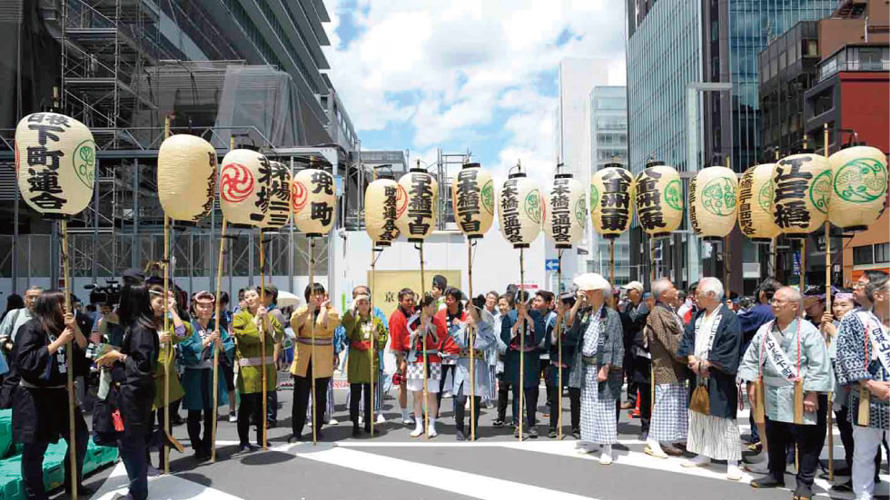


In Musashi-no-kuni province during the Kamakura period, Chichibu Shigetsugu, (later renamed Edo Shigetsugu), marched into Edo and subsequently built Edo Castle. He established Sannougu shrine by organizing a ceremonial transfer of the divided tutelary deity from Kawagoe Sannougu shrine and thus Hie Shrine began. When Ota Dokan later built Edo Castle on the site where a fortress of the Edo clan was located in the Bunmei years (1469-1486) of the Muromachi period, he worshipped at this shrine by once again inviting the divided tutelary deity from the Kawagoe Sannougu shrine into the castle.. When Tokugawa Ieyasu entered Edo Castle in the 18th year of Tensho (1590), he built a new shrine inside the castle on Momijiyama. For generations the Tokugawa family worshipped at this shrine which they considered the “Tokugawa rekicho no ubugami” (tutelary deity of the Tokugawa family), and the citizens of Edo believed this to be the “supreme tutelary deity.” During the rule of the second Shogun Hidetada, when Edo Castle expanded, the shrine was moved to outside the Hanzomon gate of the Castle, near the current National Theatre. After the Great Fire of Meireki in 1657 the shrine was moved to the Hoshigaoka area, a place of scenic beauty overlooking Akasaka Tameike, and it has remained there to the present day.
镰仓时代,秩父重继(江户氏)进军江户,建立了江户城,从川越迎接来山王宫的分灵祭拜,这就是日枝神社的开始。之后的室町时期文明年间(1469~86年),大田道灌在江户氏馆址上建造江户城之际,再次将川越山王社迎接到城内。天正18(1590)年德川家康一入主江户城,就在城内的红叶山上建造了新社殿。作为“德川历朝的产神”,江户市民尊其为“江户乡的总产神”。二代将军秀忠时代,伴随江户城的扩建,其又搬迁到了半藏门外,即今天的国立剧场附近。然后在明历大火之后,最终迁移到了面临溜池的风景名胜区直至今日。
Since Ota Dokan worshipped the Hie Shrine’s divided tutelary deity, the guardian of Edo Castle, Kawagoe Sannosha, the Sanno Festival has been held each year in June for more than 500 years. Around the time of the third Shogun Iemitsu, a procession of dashi (floats) and mikoshi (portable shrines) was allowed to enter Edo Castle and since then, the Sanno Festival has been flourishing as the “Tenka matsuri (State Festival),” which the shoguns observed. It is considered to be one of the three major Japanese festivals, along with the Gion Festival in Kyoto and the Tenma Festival in Osaka. Around the time of the fifth Shogun Tsunayoshi in the first year of Tenna (1681), it was decided by a decree that is now considered to be a forerunner of the Kenyakurei (laws regulating expenditures), that the major festival of the Sanno Festival should be held every other year, alternating with the Kanda Festival.
The Sanno Festival is a collective term that includes more than 20 festivals held before and after the Reisai Houhei on June 15. The Jinkosai, the largest parade, which is held only during the major festival years, coincides with displays of splendid period picture scrolls in the city center. The Rengotogyo (parade of mikoshi) by shrine parishioners is also a must-see.
自大田道灌再次迎接日枝神社后的500多年以来,每年6月份都会举行山王祭。从3代将军家光时候开始,山车和神轿的行列就被允许进入江户城内。自此,将军观赏的“天下祭”达到了鼎盛时期。它与京都的祗园祭,大阪的天满祭并称为日本三大祭典。5代将军纲吉时候,由于被认为是节俭令前奏的天和元年(1861年)告示,最终正式祭典变成了与神田祭隔年交替进行。
并且“山王祭”以6月15日的例祭奉币为中心,包括在此前后举行的20多个祭典。“神幸祭”巡幸是祭祀中最隆重的仪式且只在本祭中进行,在都心不断地展现华丽的时代画卷。受神社守护的居民(氏子)进行的町神轿联合巡游也不可错过。
During the Edo period at the Sanno Festival, dashi were drawn by shrine parishioners and later in the Meiji period, mikoshi were used. After the Second World War however, as mikoshi carriers have been decreasing due to accelerated urbanization, the vigor of the mikoshi togyo (parade of mikoshi) in each town has been lost. And so, in 2002 young people living in Nihonbashi in the Shitamachi area (an area equivalent to the castle towns in the Edo period) who had developed a sense of urgency about the matter, decided to call the neighboring town of Kyobashi to join the mikoshi togyo, and the Mikoshi no Rengotogyo (parade of mikoshi in the township) began. The area of Kayabacho joined in 2006 and Hacchobori in 2008 and now the Rengotogyo is held with the entire Shitamachi area..
在举行山王祭时,江户时代居民们用手抬山车,而明治以后则是抬神轿。但是,战后城市化进程加快,抬轿人手减少,各町会的神轿巡游也失去了活力。于是,感觉到危机感的“下町地区”(江户时代所指的城周边地区)的日本桥年轻人与临近的京桥商量,从平成14(2002)年开始进行“町会神轿联合巡游”。平成18(2006)年、20年又分别加入了茅场町和八丁堀,目前“下町”全体合作进行联合巡游。
※下町連合発行、月刊東京人制作「山王祭」2014年より転載
(写真・大八木宏武)
